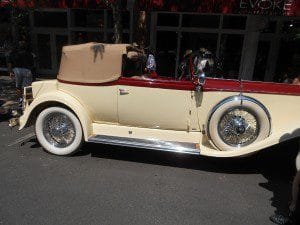The car pictured in this article is a 1927 Rolls Royce Phantom One Dietrich Victoria Convertible. The convertible Rolls Royce car is high on the collector’s list. The Rolls Royce Motors has been producing automobiles since 1904. For over 100 years this company has been an automotive icon. The company was founded by Charles Stewart Rolls and Henry Royce. Charles Rolls was an engineer who reportedly was dissatisfied with the car he was driving and wanted to build a better one.

He partnered with Henry Royce who was a businessman and aviator with good talents for marketing. History would go on to prove that it was a good combination.
During the first two years Rolls Royce built forty cars all withe a four cylinder 20 HP engine. In 1906 the six cylinder Silver Ghost was introduced with quite a lot of fanfare. The company entered their Silver Ghost in the Tourist Trophy Race and came in number one. This did much in showcasing the attributes of the new Silver Ghost to the public.The Silver Ghost acquired the reputation for durability and reliability which was what the public seemed to want. As far as marketing their cars, Rolls Royce targeted the wealthy element of society and their prices proved it.
The Rolls Phantom model replaced the Silver Ghost model. The Silver Ghost was the only model the company produced for it’s first fifteen years. The New Phantom came on the scene in 1925 with a larger engine than the Silver Ghost but utilized the same frame as the Silver Ghost. The Rolls Phantom was the flagship model for the company. The best upgrade from the Silver Ghost was the engine which was cast in three blocks, each containing two cylinders. The engine was attached to the four speed gearbox with rubber coupling. The Phantom I arrived in 1927 and the Rolls Phantom II in 1929. The automobile was produced both in England and in the United States.

The automobile did have some differences between the British and U.S. manufactured models. The British car had the fuel gauge at the fuel tank whereas many American models had it on the dashboard. There were also some differences with the transmissions and wheelbase length. Another interesting thing was that while the chassis and mechanical parts were made by Rolls Royce, the body was produced by several coach builders with the owner choosing which one to employ. One well known coach builder for Rolls Royce was Barker & Company. Barker was the recommended body builder for Rolls Royce at one time. Nevertheless, the customer did have the option to use others. Barker did work for other automotive companies in addition to Rolls Royce and Bentley, such as with Mercedes-Benz. Bentley was acquired by Rolls Royce during the Great Depression.
Some might remember when the Rolls Royce auto company was involved in building jet engines. At one point, the company was nationalized because of the cost of building jet engines but the automotive sector was eventually spun off by the British government as the Rolls Royce Company in 1973.

One company manufacturing cars and jet engines apparently wasn’t a good business model.
Vintage Rolls Royce automobiles are among the highest priced cars on the classic used car market. Vintage and used are really two different things. Whereas many will say that new rolls Royce models depreciate rapidly, finding and buying a vintage Rolls may and probably does have all the depreciation priced in. If you’re fortunate to have the opportunity to invest in an older model at the right price and in the right condition, it could work out to be both a fine investment and a lot of fun to own.
Some of the best venues to view classic Rolls Royce models include the Blackhawk Museum in Danville California about 25 miles east of the San Francisco Bay area, the Petersen Automotive Museum in Los Angeles California, the new LeMay Museum in Tacoma Washington, the Springfield Museums Auto Gallery in Springfield Massachusetts and the Northeast Classic Car Museum in Norwich New York. There of course are more throughout the U.S.
(Photos are from author’s private collection)